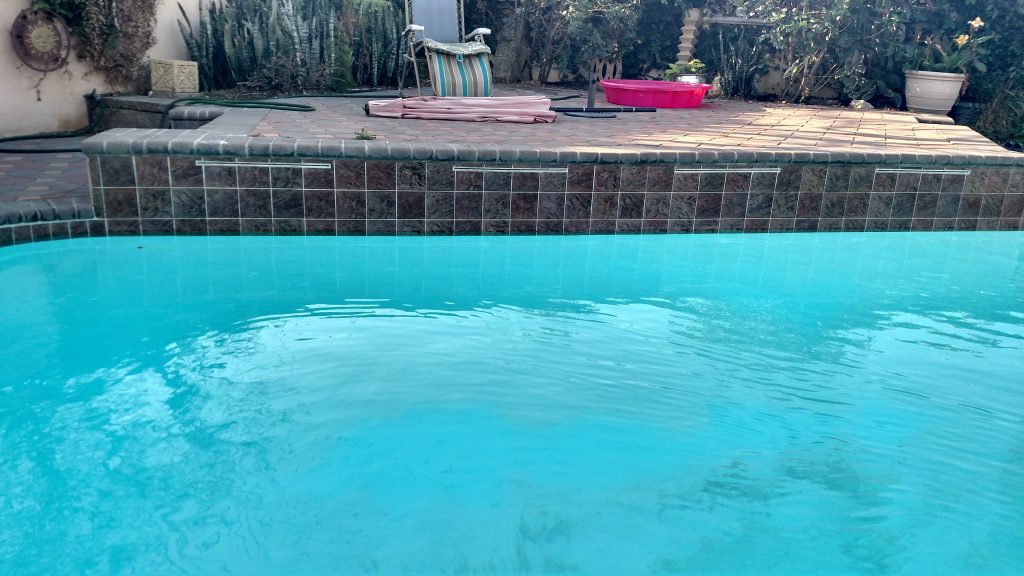It can happen for various reasons that your pool water becomes cloudy or whitish. Don’t panic, this happens to just about every pool owner.
I will show you in this article the different possible causes for this problem and the appropriate treatments.
Caution: Always check the compatibility of your equipment before using specific products.
Why is my pool water cloudy or whitish?
To find an effective solution to this problem, you must first know its origin. Here is a list of possible causes that can make your pool water whitish or cloudy:
- Water naturally rich in limestone: This is the most common cause
- A problem related to the filtration system: When the filtration equipment can no longer keep up (worn out or not powerful enough) or when it is simply faulty.
- Unsuitable water treatment: For example, an under-dosage of a disinfectant can lead to the development of microorganisms responsible for whitish water.
- A water balance problem: Poor pH balance combined with high temperature.
- After an anti-algae treatment: Following the treatment, dead algae can remain suspended in the water, creating a cloudy/whitish effect in the water.
- A degraded coating: The concrete or coating can degrade over time and come off in the water.

Hard water: Very calcareous
Naturally, calcareous water is called “hard water”, i.e. water rich in calcium and magnesium which is more or less strong depending on the region and which may have the following harmful effects:
- White deposits suspended in your pond
- Poor effectiveness of disinfectants
- Increased algae bloom
- Reduced life of equipment/coating
- Scale formation
Preventive solutions for treating hard water
Know that with regard to limestone, the most effective solution is to act preventively.
You must first measure the hardness of your water using the TH (Hydrotimetry Title) to know which products to use. Your TH should be between 10 and 20F°. If it is too low (below 10°F) the water will be corrosive (too soft) and may attack your submerged pool equipment such as ladders because of its excessive acidity. If it is too high (above 20°F) the water will become hard and this will encourage lime deposits. In addition, these deposits will proliferate more easily if the temperature of your water is high. If your TH exceeds 25F° you will have to use anti-limescale products.
You also need to monitor the pH and temperature of your water. A pH that is too high (over 7.8) and water that is too hot (over 28°C) will tend to lead to the development of calcium salt causing cloudy water.
To measure your pool water (hardness + pH) you can use an analysis kit.
Then, to avoid or eliminate the formation of limescale, use an anti-limestone treatment or limescale inhibitors 2 to 3 times a year. The first can take place when your pool is restarted after winterizing, the second in the middle of the season, and the last just before winterizing your pool. If you do not need to winterize (if you use your pool all year round), renew the anti-limestone treatment every 2 to 3 months.
Curative solutions to treat hard water
If the scale is already embedded in your coating or your filtration system, there is only one solution: drain your pool and scrub the areas of scale. Use an anti-limescale product in areas where you have not been able to remove scale.
In extreme cases, you may have to change your coating or your filtration system. To avoid this, once again, it is important to act preventively by regularly checking the state of your water!
Poor filtration
Poor filtration can be the cause of cloudy/whitish water because it allows limescale particles to pass through. In general, this occurs because of equipment that does not provide the same results as when it started (product too old or too worn) or simply because it is faulty:
- For a sand filter: If your filter is old, it is possible that the filtration is not done correctly and that the fine particles are no longer filtered! The wear of a sand filter is all the more rapid if the water is very calcareous, it is, therefore, necessary to think of changing the sand (normally every 3-5 years depending on the use and the water ).
- For a cartridge filter: Make sure to replace your filter regularly to prevent it from clogging.
- For a diatomite filter: check that the membrane of the filter is not pierced because diatomite could flow into your pool and create a whitish effect.
Solutions to treat cloudy water in case of poor water filtration
In general, it is enough just to check the condition of the filter. Look at its pressure gauge to check that the filter is not clogged (under pressure). If necessary, you will have to rinse and wash the filter. Attention, the water which will be used for rinsing must be evacuated towards the sewers otherwise the cleaning will be useless.
If the filter material (sand, cartridge, diatomite) must be replaced because it is too old, first try to clean it with a product specially adapted for filters.
Once the filter has been replaced or cleaned, proceed with slow flocculation (using the skimmer baskets) in order to eliminate the particles in suspension in the water. If you have a diatom or cartridge filter, simply use a clarifying product.
Note: If the pH of your water is too high (above 7.6), adding flocculant can create the opposite effect, it becomes too soluble, passes through the filter and you get cloudy water. It is therefore always necessary to try to keep a pH level between 7.2 and 7.4.

Insufficient water treatment
It is also possible that cloudy or whitish pool water comes from an underdosing of disinfectant product which will cause a proliferation of microorganisms at the origin of this phenomenon.
Solutions for treating insufficiently disinfected cloudy water
If the underdose is not very serious, you can try to correct the error by increasing the dosage of the disinfectant. Otherwise, proceed to a shock treatment after which it will be necessary to increase the rate of the disinfectant so as not to return to the starting point!
You should also know that cloudy water can occur following a storm, here too it is advisable to carry out a shock treatment to find clear water.
Water balance problem: Incorrect pH
The pH is one of the most important elements for having clean water in good condition. If your pH is too low (below 7.2) or too high (above 7.8) your water may become cloudy. It is therefore strongly recommended to maintain a good balance of your pH level:
- between 7.2 and 7.4 for chlorine treatment
- between 7.2 and 7.6 for bromine treatment
Solutions to treat cloudy water due to an unbalanced pH
Manipulate the pH level of your water by using pH plus to raise it or pH minus to lower it. Respect the recommended values and monitor the water temperature (no more than 28°C).
After anti-algae treatment
It is quite possible that following an anti-algae treatment your pool water will take on a whitish appearance due to dead algae being suspended in the water.
Solution for treating whitish water following an anti-algae treatment
Add flocculant or clarifier to the water and run the filtration until your pool water becomes clear again. Find out more about swimming pool flocculation.
Preventive actions to avoid having cloudy and whitish water
After all these laborious steps you have finally found clean and clear water. To preserve it, clean your pool well (bottom, walls, steps, etc.) using a vacuum cleaner or a pool robot to completely remove any particles or limescale residue.
To be sure that you do not or no longer have this kind of problem, always think about preventive actions by monitoring your pool water every week: control of pH, TH, temperature, use of cleaning products, etc.



